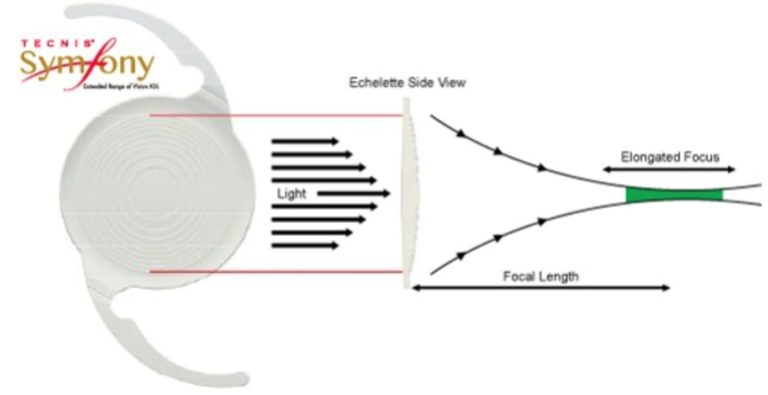PREMIUM IOLS
Premium Intraocular Lenses In New York City
Presbyopia is when your eyes gradually reduces its ability to read up close. It is a normal part of aging. This typically begins by mid-40s. The clear lens sits behind the iris, the colored part of the eye. When you are young, the lens is soft and flexible, easily changing shape. This lets you focus on objects both at distance and at near. After age 40, the lens becomes more rigid and cannot change shape as easily. This makes it harder to read or do any work up close. There is no way to pause or stop this naturally occurring process. Bifocals, contact lenses, LASIK, or cataract surgery are ways to correct presbyopia, thus not requiring reading glasses.
Customizable vision in cataract surgery aims to minimize the need for glasses after surgery. Dr. Rapoport spends time with each patient to develop an individualized plan to determine the best outcome for each person.
Below are some of the tools offered.
PREMIUM IOLS NYC
MONOVISION LENSES
Monovision
With monovision, Dr. Rapoport corrects your dominant eye for seeing at distance and your non-dominant eye for near vision, thereby reducing the need for reading glasses. When both eyes are functioning together, the brain naturally selects the image from the eye that has the clearer focus. Having eyes for different purposes might sound unsettling, but many patients do very well with monovision.
Blended vision simply refers to monovision with a smaller discrepancy between the eyes, increasing the need for reading glasses but making it easier to adjust to the difference between the two eyes.
Monovision and blended vision are common goals for patients over the age of 40, allowing patients to achieve good functional vision at both distance and near without the need for glasses or contact lenses.
Enhanced Monovision Lenses
There are currently two lenses in the USA that are Trifocal or Extended Depth of Field Lenses – Alcon’s Panoptix and Johnson & Johnson’s Symfony Lens. Both of these lenses are excellent choices for patients with active lifestyles, from requiring precise distance vision for sporting activities, to viewing mobile devices and computer screens. The near vision with these lenses is not at the same level as that of multifocal lenses, but there is less risk of glare/ halos or of compromise in distance vision.
TORIC LENSES
Toric - astigmatism correcting lens:
Advanced technology makes it possible to correct the cataracts that may be clouding your vision – and the astigmatism that may be distorting your vision – all at the same time. The Toric intraocular lens replaces your eye’s natural clouded lens during cataract surgery. It also has the ability to reduce or eliminate corneal astigmatism at the same time it corrects cataracts. Typically the result is improved distance vision and less dependence on eyeglasses. However, most patients still require corrective lenses for near and intermediate tasks. With the Toric lens, your distance vision can now be clear and vibrant following cataract surgery.

TRIFOCAL / EXTENDED DEPTH OF FIELD LENSES
Trifocal / Extended Depth of Field Lenses:
The Panoptix lens was FDA-approved in August 2019, having been used for many years in over 70 countries Similar to the Symfony lens below, is the first approved “Trifocal Intraocular Lens.
Panoptix is clinically shown to deliver an exceptional combination of near, intermediate and distance vision, reducing the need for glasses after surgery. While the lens implant looks like a multifocal lens, the optics work differently. Instead of producing two distinct focal points, the lens uses ENLIGHTEN 9R) Optical Technology, proprietary design that optimizes intermediate vision without compromising near and distance vision. It can correct both spherical and astigmatic corrections, and builds on Alcon’s proven AcrySof IQ IOL platform.
With this lens, patients, can achieve excellent clarity at distance and a range of clear vision at near for patients receiving the lens. The unique technology allows for reading vision that is at a level in between the Symfony and the traditional multifocal lenses.
Dr. Rapoport is one of the first group of surgeons in NYC to implement this lens with success in her practice.
ALCON PANOPTIX IOL
Alcon Panoptix:
The Panoptix lens was FDA-approved in August 2019, having been used for many years in over 70 countries. It is the first and only “Trifocal Intraocular Lens” and the most advanced IOL that is now available. Panoptix is clinically shown to deliver an exceptional combination of near, intermediate and distance vision, reducing the need for glasses after surgery.
While the lens implant looks like a multifocal lens, the optics work differently. Instead of producing two distinct focal points, the lens uses ENLIGHTEN 9R) Optical Technology, proprietary design that optimizes intermediate vision without compromising near and distance vision.
The lens can achieve excellent clarity at distance and a range of clear vision at near for patients receiving the lens. Before, the light would be split in two ways – for distance and for near, resulting in a potential gap in vision. With the Panoptix trifocal lens, there is no gap.
The Panoptix can correct both spherical and astigmatic corrections, and builds on Alcon’s proven AcrySof IQ IOL platform. With this lens, patients, can achieve excellent clarity at distance and a range of clear vision at near for patients receiving the lens.
The unique technology allows for reading vision that is at a level in between the Symfony and the traditional multifocal lenses. Dr. Rapoport is one of the first group of surgeons in NYC to implement this lens with success in her practice.
JOHNSON & JOHNSON SYMFONY IOL
Johnson & Johnson Symfony Lenses:
If you have a pre-existing visual condition other than cataracts that affects your vision in one or both eyes (macular degeneration, an epiretinal membrane, or Fuchs dystrophy, for example), you typically will be happier with standard monofocal IOLs rather than multifocal IOLs, which require good visual capability in both eyes for best results.
With Panoptix – you should expect to have great distance and intermediate, and relatively good near vision. You may (or may not) need to have an over-the-counter pair of reading glasses.
With personalized vision (Symfony + Tecnis Multifocal) – you should expect to have great distance, intermediate and near vision, but with the chance that you will have some glare and halos. You may need to determine what your willingness to accept some compromise in the clarity of your distance vision (with glare and halos) for the convenience of being less dependent on computer glasses and/or reading glasses after cataract surgery in deciding which of these two options you may want.





